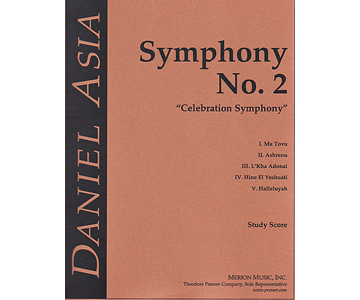for orchestra
Scoring
3-3-3-3 / 4-3-3-1 / timp+3 / pno(cel/synth) / hp / strings
Duration 26 Minutes
Movements
1. Ma Tovu
2. Ashrenu
3. L’kha Adonai
4. Hine El Yeshuati
5. Halleluyah
Recordings
Album Title
Daniel Asia: Symphonies No. 2 & No. 3
Label
New World Records [product id: 80447-2]
Sound File
Ashrenu
Performances
APRIL 30 & MAY 1, 1992
WORLD PREMIERE
Tucson Symphony Orchestra
Robert Bernhardt, conductor
Program Notes
This work is subtitled “Celebration Symphony” and was finished soon after the death of Leonard Bernstein. Like this fine composer, I have sought to make explicit in this work my deeply felt sense of Judaism, and what it means to be a Jew at the end of the 20th Century. Like my first symphony, this work was based on another piece, in this case a response to a commission from a Massachusetts synagogue. That work has been used as the basic sketches for an amplification, or elaboration into another work, this Symphony.
The work is in five movements, each one gathering in strength, commitment, and dedication. The movement titles are 1)Ma Tovu (Your love is great; answer me with true deliverance), 2) Ashrenu (Therefore it is our duty to thank and praise you.), 3) L’kha Dodi (Yours, O Lord, is the greatness and the power and the splendor), 4) Hine El Yeshuati (Behold, God is my deliverance; I am Confident and unafraid.) and 5) Halleluyah (Praise God in the Highest!).
Much of the spirit of the work is based upon my experience and understanding of music heard and sung in the synagogue. The various movements are rather simple in their formal design, with the orchestration direct and clear. The music itself is rather lean and straightforward. While no scales or modes typical of Jewish music are used in this work, the prevailing quality and sensibility is, I think, similar. The first movement is almost in ballad form, with a recurring refrain. It has a somewhat lilting rhythm. It perhaps should also be mentioned that this text is among the very first said in a Jewish prayer service. It serves to focus attention and as a “warm-up” . It serves a similar function here as the first movement. The second movement, Ashrenu, is presented as a very simple and direct utterance, with the solo cello soaring above the orchestra. The orchestra here sounds almost choir-like. The third movement, L’kha Dodi, is in three sections or utterances, referring to “greatness”, “power”, and “splendor”. This movement builds in intensity and speed, with the three sections being offset by a repeated tune in the brass and winds. The fourth movement , Hine El Yeshuati, refers to the character of of the second movement. The trombone and then the brass sound the tune. The quality of this movement moves from quietly penitential, to an outwardly directed affirmation. The final movement, Halleluyah, begins where the fourth movement left off. It is outwardly boisterous for the most part, with lilting rhythms that are reminiscent of the first movement. In the second part the music becomes somewhat more distant, the ghost of a Hasidic tune is evoked, and it is surrounded by bird calls in the flutes and piano. The piano also intones music of the fourth movement. The quality of this middle section is somewhat elegiac. It is a reflection of the Jewish tradition that all joy must be tempered by the the recognition of the presence (or historical presence of evil). The final section brings back the opening rousing material, and the work is brought to its conclusion with a sense of grand affirmation.
The work can of course be heard in a number of ways. It is certainly a work with a religious sensibility. It can also be heard as music qua music. But perhaps it is important to be said that much of the work of the musical canon, or even perhaps most art music, is spiritual in nature. Thus music and the world of the spirit are very closely intertwined. Even in this secular age, music opens the way to something other, to something transcendent.
Reviews
J. REEL, THE ARIZONA DAILY STAR
Asia is a compositional comet who has been steadily speeding in from the icier reaches of the modern solar system. For this symphony, Asia has crossed the orbits of such American composers as David Diamond, Walter Piston, and Leonard Bernstein.
K. LAFAVE, AMERICAN RECORD GUIDE
(The) peculiarly elevating juncture of restlessness and stasis, lushness and austerity, grandiosity and intimacy that the work produces speaks quietly and urgently to the human condition at large.
D. DROBATSCHEWSKY, ARIZONA REPUBLIC
Composer Daniel Asia’s Second Symphony…proved a popular success with its easily accessible harmonic structure, its relentless buildup of intensity and drama, and the infectiously rhythmical beat of its final movement.
